Foreshore plants and animals
Trees
-
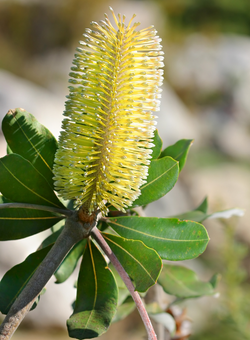
Banksia integrifolia subsp. integrifolia
The iconic coastal banksia is a real workhorse, growing in several vegetation communities, including grassy coastal dunes and dry eucalyptus forests. Its shape can change according to the condition it is growing in, from dense shrubs with small leaves on exposed frontal dunes to large (up to 20 m) spreading trees in more protected areas.
While regarded as tricky to grow by some, and sensitive to phosphorous fertilisers, the coastal banksia can be a great addition to a free-draining garden. Its showy, large, yellow flowers, glossy leaves and gnarled bark and structure make it a wonderful feature tree. And the native bird and animals that come to eat both the flowers and woody seeds are a fabulous addition to your garden or park.
Plant me instead of umbrella tree, broad leaf pepper.
-
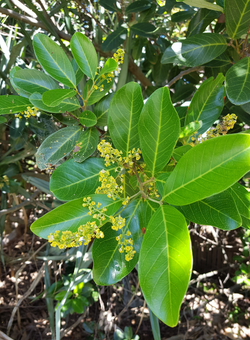
Acronychia imperforata
Tough as old boots, beach acronychia grows from the front of the secondary dune, right though the protected swales and hind dunes and is often found in patches of littoral rainforest. It grows smaller and denser, shaped by the wind in exposed areas and taller (up to 15 m) and more open in the protected hind dune. The creamy colour flowers attract butterflies and other insects and the pale-yellow fruit is enjoyed by many native bird and animals.
The glossy dense leaves and 4 to 6 metre spread means that beach acronychia can be a valuable addition to a coastal free draining garden. It's adaptability when growing wild is reflected by its adaptability as a garden plant - while it can grow as an open spreading tree, when it is planted and pruned closely it will happily grow as a hedge.
Plant me instead of umbrella tree, broad leaf pepper.
-
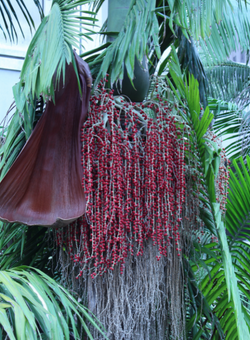
Archontophoenix cunninghamiana
A slender, straight growing palm that grows to 25 metres in the protected hind dune swales, in creeklines and littoral rainforest. The large bright green fronds grow up to 4 metres long and are slightly paler underneath, nowhere near as pale as the underside of non-local alexander palms. The large panicles hold masses of pale purple, scented flowers that attract native bees. Later, small, round, red fruit attracts bird and possums.
Piccabeens palms happily grow in many different soil types where there is a bit of moisture and protection and can be a spectacular group or single planting in a garden. The fronds drop off the trunk themselves, making maintenance in a garden a bit easier. The autumn flowers attract pollinators to your garden, and the red fruits can be a useful winter food source for birds, bats and animals.
Plant me instead of alexander palm and cocas palm.
-
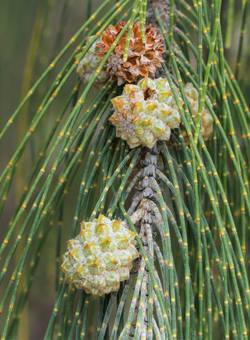
Casuarina equisitifolia var. incana
The grey green weeping foliage and dark grey trunk of coastal she-oaks are an iconic part of Noosa’s coastal look and feel. These are the trees that venture closest to active coastal foreshores and take the brunt of fierce storms and coastal erosion. Coastal she-oak reduce the impacts of high winds and storm surges by slowing wind and water and holding the foredunes together. They also help protect the vegetation behind then from salt spray and fierce winds.
The coastal she-oak grows to about 10 meters and can be a great addition to a free-draining coastal garden, especially where salt is a concern. The grey-green needles frame views beautifully and the sighing sound of the wind blowing through them is the sound of the Australian coast. Black cockatoos love the seeds in the tough woody cones. They self-mulch, so plant them in a garden bed where the thick layer of needles will work for you.
Plant me instead of slash pine
-

Callitris columellaris
Another workhorse plant, Bribie Island pine grows in several vegetation communities, including dune forests, range woodlands and eucalypt forests, and in all Australian states except Tasmania. Perhaps as a result of its wide distribution and forestry use, it has at least 20 common names, but is best known as the Bribie Island Pine in SEQ. Growing up to 30 metres in protected areas, the bright green, cypress-like foliage provides fine broken shade and works as a windbreak. The small round cones on the female trees are treasured as a food source by small parrots and cockatoos.
Highly adaptable, the Bribie Island pine will thrive in free draining soil anywhere except the most exposed coastal sites. The dark grey furrowed bark, beautiful foliage and open layered habitat can make a spectacular specimen tree in an open lawn or can work as a hedge in a large garden if more closely planted and pruned.
Plant me instead of slash pine and exotic cypress
Shrubs
-
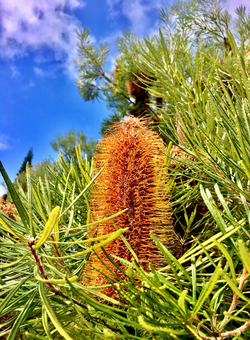
Banksia spinulosa var. spinulosa
A shrub that grows up to 3 metres, the large yellow spike flowers are both spectacular to look at in the garden and for attracting birds. It grows in sand on dunes and nearby eucalypt woodland and forest in scattered pockets along the East Coast, including here in Noosa. While it is slow growing, it can take a heavy pruning, and will regrow reliably back from its ligno-tuber.
Grow me instead of coral berry
-
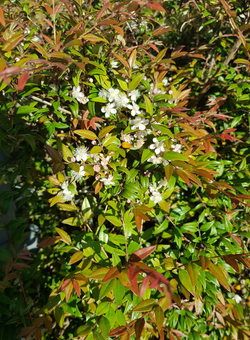
Austromyrtus dulcis
Another widely distributed plant that grows happily in free draining soils from the dunes to open forest. A small shrub growing to about 1 metre high but can easily spread more than a metre widthways in the right conditions. The pinky-bronze new growth on its attractive small leaf foliage, masses of small pinky-white flowers and purple and white fruits make this a highly attractive addition to all but the most exposed free-draining gardens. It will thicken up with judicious pruning.
The flowers attract nectar eating insects and birds and the juicy fruits attract a range of native birds and animals.
Grow me instead of Brazilian cherry
-
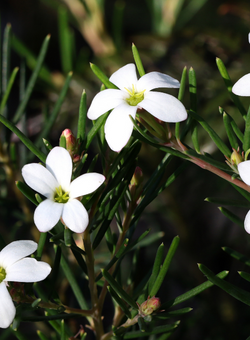 Ricinocarpus pinifolius
Ricinocarpus pinifoliusGrowing in dunes and coastal heath to open eucalypt forest, the massed white flower display in spring is spectacular. This beautiful display is long lasting and well worth the space in a free draining sand garden. It grows to about 2 metres and attracts pollinators to your gardn.
Grow me instead of Indian hawthorn
-
Photo courtesy of Coolum Native Nursery
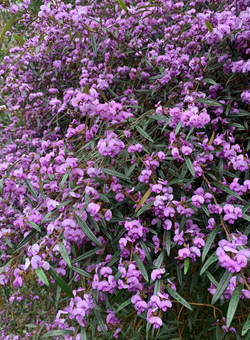 Hovea acutifolia
Hovea acutifoliaA perennial small shrub that grows in sun and light shade in free draining forest margins. While foliage is nondescript and form can be a little sparse, the massed purple pea flowers in spring more than make up for it. Try grouping it for more impact or use it for splashes of spring colour. If you get the conditions in your garden right, purple pea bush will happily self-seed to keep your display going year after year. The bright purple flowers and hard pea pod seeds attract native bees and parrots to your garden.
Grow me instead of lantana
Understory plants
-

Zoysia macrantha
Prickly couch is native to much of eastern coastal Australia and grows happily in exposed areas of the dunes. Salt tolerant, exposure tolerant, and handles being buried by sand, prickly couch is outstanding at holding surface sand in very harsh conditions,
A select form of native prickly couch has been developed as a turf grass and is now widely available - there are a couple of non-native zoysias used for turf so make sure you get the right one. The turf select form is soft and dense under-foot and handles drought and salt much better than many other turf species.
Grow me instead of Queensland Blue Couch, bent grass, kikuyu, non-native zoysia
-
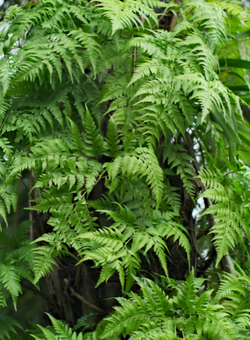
Davallia pyxidate
An epiphytic fern that grows in cracks in rocks, on trees or in the baskets of other larger epiphytic ferns. It is named after the brown furry rhizomes (or underground stems) that can look like a hare’s foot and protrude several centimetres from tis growing surface. The glossy green lacy fronds grow to approximately a metre high. It is very low maintenance in a sheltered spot and does great in a hanging basket or indoors.
Grow me instead of asparagus fern.
-

Photo courtesy of Coolum Native Nursery
Dianella caerulea
Widely available, and with many select forms, flax lily will happily grow in many gardens except for the most exposed. Tufts of strappy, dark-green leaves up to 1.5m are offset by the beautiful blue flowers and rich purple-blue fruits. These fruits are highly attractive to many native birds and animals – I’ve even caught the resident water dragon climbing up on garden furniture to get to them. They are easy to grow, require little maintenance when established and will happily self-seed if conditions are right.
Grow me instead of purple joyweed
-
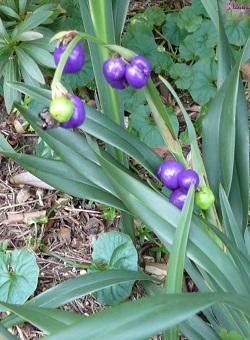
Photo courtesy of Coolum Community Native Nursery
Dianella congesta
The Beach flax lily has paler blue flowers and fruit than the common flax lily, and is not as widely available, but is more able to handle seaside conditions. The fruits are just as attractive to native animals and birds. They are easy to grow, require little maintenance when established and will happily self-seed if conditions are right.
Grow me instead of mother of millions
-
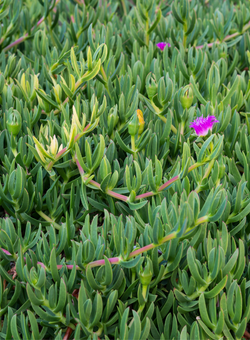
Carpobrotus glaucescens
With only spinifex and a couple of vines growing closer to the sea, pigface is a vital foredune sand stabiliser. With interesting fleshy foliage and brightly purple. It happily grows in a range of free draining gardens and handles even extremely exposed and salty positions. Extremely hardy, they need little maintenance and will spread from seed and shoot if conditions are right. It is widely available - look for several select forms with interesting foliage and flower colours.
Grow me instead of Singapore Daisy
-
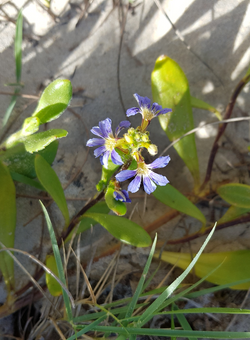
Scaevola calendulacea
A found in the foredune forb-lands, the slightly fleshy lobes leaves set off the pretty blue fan flowers. The juicy purple fruit attracts native animals. It will thrive in many free draining gardens and handle tough seaside conditions. Look for select forms with larger, brighter flowers or enjoy the subtle beauty of the original.
Grow me instead of asparagus fern
Animals
-
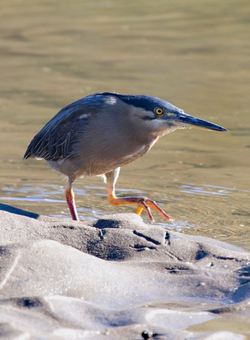
Butorides striatus
A hunched, small heron with dark grey back and grey to reddy grey underside. Black cap with droopy crest, black and white streaks on throat and sharp, long yellow and grey beak. Their short yellow legs turn orange during the breeding season. They flick their short, stubby tail as they walk.
They live on foreshores, estuaries and mangroves, hunting for fish, crabs, crustaceans and insects in the shallows all year round. Striated Heron sometimes drop a leaf or feather onto the surface of the water and snatch fish that come to investigate.
Striated Heron build a stick platform low in trees or shrubs and occasionally on the ground, which makes them vulnerable to feral and domestic predators. They lay 2 to 5 pale-blue 3.6cm long eggs. Both parents share nestbuilding, incubation and care responsibilities and may raise two clutches each breeding season.
-
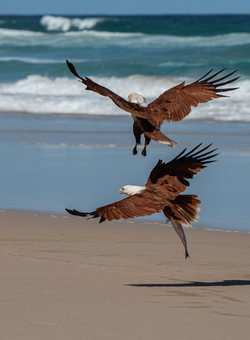
Haliastur indus
A medium sized raptor often seen above dunes and beaches, larger rivers and some wetlands. It’s bright white head and chest contrasts strongly with the reddish brown body and wings and is unmistakable.
They mostly feed on dead animals, fish and insects, but may also fish for live fish in the sea or harass other fish-eating birds and steal their prey.
Brahminy Kites breed from August to October in SEQ, and then make a stick bowl nest in coastal trees, often mangroves. They lay 2 grey-white 5cm eggs. Both parents share nest building and feeding but it looks like only the female incubates the eggs.
-
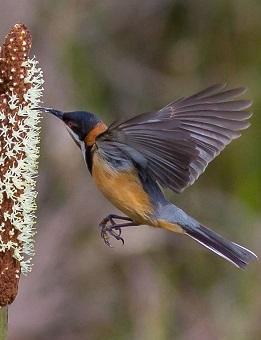
Acanthorhynchus tenuirostris
A small (15cm) bird with grey body, white throat with reddish patch, reddish and cream underside. Its distinctive thin, long, curved beak cause some people to call it the Australian Hummingbird, although it doesn’t have the flight and metabolic capabilities of true hummingbirds.
Eastern Spinebills live in forests heaths and mangroves and feed on nectar and insects often taken on the wing. While they readily feed on open flowers like grevilleas, their long beak allows them to feed on tube flowers that many other birds or mammals can’t access.
Eastern spinebills tend to live in one area all year around but may move between local lowlands and mountains. They make a small, neat cup of spiderweb, bark and twigs 1 to 45 metres off the ground. The female does the nestbuilding and incubation and both parents share feeding duties.
-

Varanus varius
A large lizard (up to 2 metres) with grey and black covering body, palish yellow spots and stripes.
Most commonly found in forests and woodlands. Spend a lot of their time on the ground but will quickly scuttle up a tree when you come close. They tuck themselves in tree hollows and hollowed stumps to hide from extreme weather conditions.
Lace monitors breed in the season of spring. During this season, the males become extremely aggressive towards other males.
-

Philemon corniculatus
A medium sized bird with black head bare of feathers and silver/grey body, found in forest clearings, golf courses, parks and gardens.
They eat nectar, fruit, insects and other invertebrates and occasionally eggs or baby birds. Noisy friarbirds breed in the months between July and January and build a large, deep cup shaped nest using bark and grass.
-
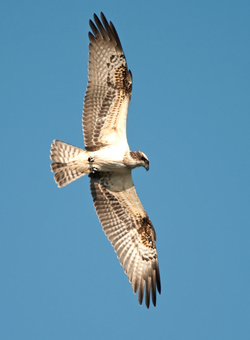
Pandion cristatus
Dark brown feathers covering its wings and small parts of its face and chest, the legs, body, and face are covered in white feathers. Length 50-65 cm, wingspan 45-170 cm.
Ospreys live near water where large numbers of fish are present. They are regularly found around large lakes, reservoirs and rivers. They are a diurnal species, ranging out from their nest or perch over water bodies during daylight.
Ospreys breed between September-October in southern Australia, April-July in northern Australia and June–August in Queensland.
-
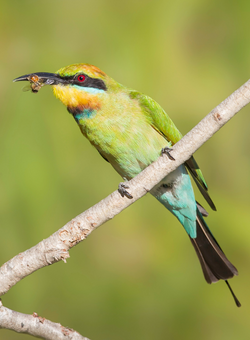
Merops ornatus
A striking medium bird with green and blue feathers covering the body, orange, yellow, green and black head and distinctive tail streamers. They are found in forest, woodlands, wetlands, heath, watercourses, lightly timbered areas, farms, playing fields, parks and gardens.
Rainbow bee-eaters are very sociable birds and roost in large groups in the dense undergrowth or in large trees outside of the breeding season. Breeding season is before and after the rainy season in the north, and from November to January in the south. They often make nest hollows in the ground, on an embankment or a cutting.
For more information on foreshore animals:
For more information on foreshore plants:
